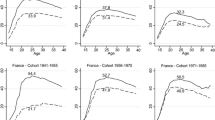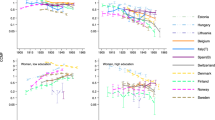Abstract
Objectives
The aim of this study is to analyse longitudinally, the annual effects of age group and birth cohort on smoking in the Swedish population during a 24-year period and to analyse the smoking trends for different levels of education.
Methods
A random sample of adult, non-institutionalized persons aged 16–71 years was interviewed every 8 years by professional interviewers. In addition to three time-related variables—year of interview, age at the time of the interview, and year of birth—we included the following explanatory variables in the analyses: sex, educational level, and urbanization.
Results
We found significant decreases in smoking prevalence in all studied subgroups. The adjusted odds ratios for age were 0.89 (95 % CI 0.88–0.90) and 0.92 (95 % CI 0.91–0.93) for men and women, respectively. The decreases in smoking over time were significant in all levels of education, except for in women with low educational level.
Conclusions
In Sweden, the prevalence of smoking has decreased in most age groups and cohorts, and in persons in most levels of education, albeit less so in women with low educational level.
Similar content being viewed by others
References
Allender S, Balakrishnan R, Scarborough P, Webster P, Rayner M (2009) The burden of smoking-related ill health in the UK. Tobacco Control 18(4):262–267
Blakely T, Wilson N (2005) The contribution of smoking to inequalities in mortality by education varies over time and by sex: two national cohort studies, 1981–84 and 1996–99. Int J Epidemiol 34(5):1054–1062
Bolin K, Borgman B, Gip C, Wilson K (2011) Current and future avoidable cost of smoking—estimates for Sweden 2007. Health Policy 103(1):83–91
Bostrom G (2006) Chapter 9: habits of life and health. Scand J Public Health Suppl 67:199–228
Carnethon MR, Lynch EB, Dyer AR, Lloyd-Jones DM, Wang R, Garside DB, Greenland P (2006) Comparison of risk factors for cardiovascular mortality in black and white adults. Arch Intern Med 166(11):1196–1202
Cavelaars AE, Kunst AE, Geurts JJ, Crialesi R, Grotvedt L, Helmert U et al (2000) Educational differences in smoking: international comparison. BMJ 320(7242):1102–1107
Cuzick J (1985) A Wilcoxon-type test for trend. Stat Med 4:87–90
European Commission (2010) Special Eurobarometer 332 “Tobacco”/Wave 72.3—TNS Opinion and Social. http://ec.europa.eu/public_opinion/archives/ebs/ebs_332_en.pdf. Accessed 15 Nov 2013
Fernandez E, Schiaffino A, Borras JM, Shafey O, Villalbi JR, La Vecchia C (2003) Prevalence of cigarette smoking by birth cohort among males and females in Spain, 1910–1990. Eur J Cancer Prev 12(1):57–62. doi:10.1097/01.cej.0000043743.13672.a7
Frank PI, Morris JA, Frank TL, Hazell ML, Hirsch S (2004) Trends in smoking habits: a longitudinal population study. Fam Pract 21(1):33–38
Giskes K, Kunst AE, Benach J, Borrell C, Costa G, Dahl E et al (2005) Trends in smoking behaviour between 1985 and 2000 in nine European countries by education. J Epidemiol Community Health 59(5):395–401. doi:10.1136/jech.2004.025684
Gorber SC, Schofield-Hurwitz S, Hardt J, Levasseur G, Tremblay M (2009) The accuracy of self-reported smoking: a systematic review of the relationship between self-reported and cotinine-assessed smoking status. Nicotine Tob Res 11:12–24
Huisman M, Kunst AE, Mackenbach JP (2005a) Educational inequalities in smoking among men and women aged 16 years and older in 11 European countries. Tob Control 14(2):106–113
Huisman M, Kunst AE, Mackenbach JP (2005b) Inequalities in the prevalence of smoking in the European Union: comparing education and income. Prev Med 40(6):756–764
Idris BI, Giskes K, Borrell C, Benach J, Costa G, Federico B et al (2007) Higher smoking prevalence in urban compared to non-urban areas: time trends in six European countries. Health Place 13(3):702–712
Lee PN, Forey BA, Coombs KJ (2012) Systematic review with meta-analysis of the epidemiological evidence in the 1900s relating smoking to lung cancer. BMC Cancer 12(1):385
Lim SS, Vos T, Flaxman AD, Danaei G, Shibuya K, Adair-Rohani H et al (2012) A comparative risk assessment of burden of disease and injury attributable to 67 risk factors and risk factor clusters in 21 regions, 1990–2010: a systematic analysis for the Global Burden of Disease Study 2010. Lancet 380(9859):2224–2260
Mackenbach JP, Huisman M, Andersen O, Bopp M, Borgan JK, Borrell C et al (2004) Inequalities in lung cancer mortality by the educational level in 10 European populations. Eur J Cancer 40(1):126–135
Osler M, Prescott E, Gottschau A, Bjerg A, Hein HO, Sjol A, Schnohr P (1998) Trends in smoking prevalence in Danish adults, 1964–1994. The influence of gender, age, and education. Scand J Soc Med 26(4):293–298
StataCorp (2009) Stata statistical software. Release 11. StataCorp LP, College Station
Statistics Sweden (1996) The Swedish survey of living conditions. Design and method. Stockholm
Thun MJ, Carter BD, Feskanich D, Freedman ND, Prentice R, Lopez AD et al (2013) 50-year trends in smoking-related mortality in the United States. New Engl J Med 368(4):351–364
Thyrian JR, Panagiotakos DB, Polychronopulos E, Willemsen MC, Zatonski W, John U (2010) The exposure to environmental tobacco smoke and attitudes towards tobacco control measures—a comparison of 5 European countries. Cent Eur J Public Health 18:87–92
van Meijgaard J, Fielding JE (2012) Estimating benefits of past, current, and future reductions in smoking rates using a comprehensive model with competing causes of death. Prev Chronic Dis 9:110295
Wärneryd B (1991) Återintervjustudie i undersökningen av levnadsförhållanden 1989 (ULF) (Living conditions. Reinterview in ULF 1989) Appendix 12. In Swedish. Stockholm
Acknowledgments
This work was supported by grants awarded to Dr. Kristina Sundquist from the Swedish Research Council and the Swedish Council for Information on Alcohol and Other Drugs (CAN), and to Dr. Jan Sundquist from the Swedish Research Council, the National Institute on Drug Abuse (R01 DA030005), the Swedish Council for Working Life and Social Research as well as by ALF funding from Region Skåne awarded to Jan Sundquist and Kristina Sundquist. We are indebted to Stephen Gilliver for his expertise and invaluable advice in editing the manuscript.
Author information
Authors and Affiliations
Corresponding author
Rights and permissions
About this article
Cite this article
Midlöv, P., Calling, S., Sundquist, J. et al. The longitudinal age and birth cohort trends of smoking in Sweden: a 24-year follow-up study. Int J Public Health 59, 243–250 (2014). https://doi.org/10.1007/s00038-013-0535-5
Received:
Revised:
Accepted:
Published:
Issue Date:
DOI: https://doi.org/10.1007/s00038-013-0535-5




